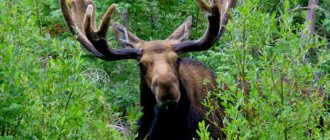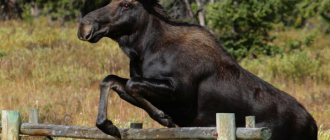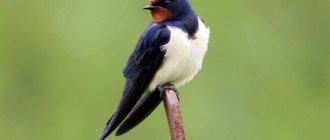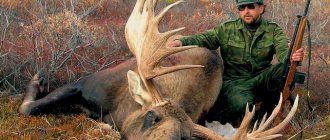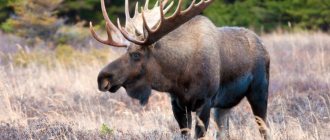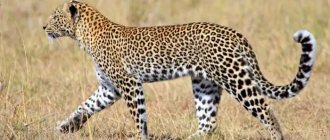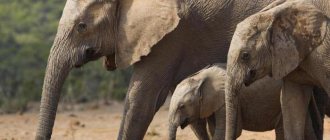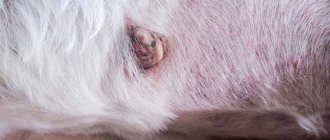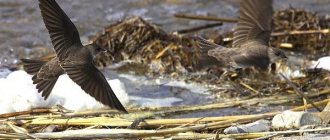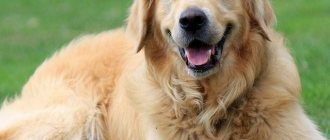Description of moose
Male moose are about 3 m long, their height reaches 2.3 m, their tail is 12-13 cm long, and their weight ranges from 360 to 600 kg.
Females are slightly smaller in size. The appearance of the moose is very characteristic and differs markedly from its relatives, the deer. The body and neck of the elk are short, the withers look like a hump, and are high. The limbs are elongated; for this reason, at a watering hole, the animal goes deep into the water or kneels down. The head is large, hook-nosed, the upper lip is fleshy and overhanging. Under the throat there is a soft outgrowth of skin, the so-called “earring”, 25-40 cm in length. The fur is coarse, brownish-black, the limbs are light gray, almost white. The hooves are pointed and are used by elk as weapons in fights with predators, wolves and bears: one blow is enough to break through the skull or rip open the attacker’s stomach. — Advertising —
Males are distinguished by large spade-shaped horns, their span is up to 180 cm, the weight of the horns is 20-30 kg. The antlers are shed every year in November-December and grow back in April-May. Females do not have horns.
Notes
- Sokolov V. E. Five-language dictionary of animal names. Mammals. Latin, Russian, English, German, French. / under the general editorship of academician. V. E. Sokolova. - M.: Rus. lang., 1984. - P. 125. - 10,000 copies.
- 1 2 3 Losi / Shchipanov N. A., Averyanov A. O., Baranov A. V. // Lomonosov - Manizer. - M.: Great Russian Encyclopedia, 2011. - P. 61-62. - (Great Russian Encyclopedia: / chief editor Yu. S. Osipov; 2004-2017, vol. 18). — ISBN 978-5-85270-351-4.
- Genus Alces: // Mammal Species of the World. — Bucknell University (Accessed September 26, 2019).
- Alces alces Linnaeus, 1758 - Elk. Vertebrates of Russia. Institute of Problems of Ecology and Evolution named after. A.N. Severtsov Russian Academy of Sciences. Retrieved April 7, 2013. Archived April 14, 2013.
- Nagorny B. A. Geography of the Rostov region: A textbook for students in grades 7-8 of eight-year and secondary schools. — Rostov n/a: Book. publishing house, 1985. - 96 p. — From 41.
- Elk (species of the deer family) // Great Soviet Encyclopedia: / Ch. ed. A. M. Prokhorov. — 3rd ed. - M.: Soviet Encyclopedia, 1969-1978.
- Website about moose
- Unusual monuments of Moscow - Monument to the Elk (inaccessible link). Retrieved July 13, 2014. Archived January 11, 2012.
- Images of moose, mainly in coats of arms, but also in other emblems and signs.
> Literature
- Timofeeva E. K. Los. - L.: Publishing house Leningr. University, 1974. - 192 p. — 18,000 copies.
Moose nutritional features
The diet of moose includes trees, shrubs and herbaceous vegetation, as well as moss, lichens and mushrooms. In the summer, these are foliage that the animal is able to reach from a great height, aquatic and semi-aquatic plants (watch, marigold, egg capsule, water lily, horsetail), tall grasses such as fireweed and sorrel. At the end of summer, moose eat mushrooms, blueberry and lingonberry branches, and berries. With the beginning of autumn, they bite off shoots and branches of trees and shrubs and by the end of autumn they switch to food from the branches. The winter food of moose is willow, pine, fir, aspen, rowan, and birch, the bark of which they gnaw. Per day, an adult requires: in summer up to 35 kg of food, in winter from 12 to 15 kg, per year the figure reaches 7 tons. For this reason, large populations of moose damage forests and plantings. Moose also actively visit salt licks.
Preparing for the mating season
To successfully reproduce, budgies need to find a partner.
These parrots are different from most other birds in that sympathy is important to them.
Some artificially created couples may not begin breeding offspring for several years, as there is antipathy. Therefore, it is worth selecting from young animals those individuals that have already independently formed an alliance.
They will make good producers.
The time of year is important. The favorable period for reproduction is warm and sunny weather, that is, healthy offspring grow in late spring, summer and early autumn. Winter and late autumn require the creation of additional conditions.
These include:
- amount of light up to 16 hours a day due to electric lighting;
- the room temperature is positive, optimally 18-20°C;
- the cage should contain fresh greens, branches of rowan, linden and other trees.
Even if these conditions are met, offspring produced in early spring or winter may not receive enough light and vitamins, which makes their growth painful.
Moose distribution
The moose's habitat includes the forest zone of the Northern Hemisphere, as well as forest-tundra, forest-steppe and the outskirts of steppe zones. In Europe, the species is distributed in countries such as Poland, the Czech Republic, Hungary, Belarus, Ukraine, Scandinavia, the European part of Russia, and the Baltic countries. In Asia, elk are found from northern Mongolia to northeastern China and northern taiga. It is also found in North America (Alaska, Canada, USA). In Russia it lives up to the Rostov region and the Pacific coast. It is here that about half of the entire animal population lives. In total, there are now up to one and a half million moose on the planet.
Common types of moose
Several subspecies are known for moose, the number of which varies from 4 to 8. The largest moose with large antlers is the Alaskan subspecies A. a. gigas and East Siberian A. a. Pfizenmayeri. The smallest moose with antlers resembling deer are the Ussuri subspecies A. a. cameloides. Sometimes the Eurasian and American subspecies Alces alces and Alces americanus are also distinguished.
Moose behavior
Moose live in various forests, willow thickets on the banks of steppe rivers and lakes, in birch and aspen forests in the forest-tundra.
In summer, they can leave the forests for considerable distances. It is important for the animal to have a swamp, quiet river or lake in its habitat in order to escape the heat and eat aquatic vegetation. In winter, elk prefer mixed and coniferous forests with dense undergrowth. If the snowfall is no more than 30-50 cm, then the elk lives sedentary in such places; if the snow level is above 70 cm, it wanders to less snowy places. It moves to wintering grounds gradually from October to December-January. First, females with cubs leave, then adult males. Every day they are able to walk 10-15 km. In the spring, with the melting of the snow, reverse migration occurs. The lifestyle of moose depends on the time of year. In summer, they are nocturnal animals, which during the day often hide in the water or in dense forests. In winter, on the contrary, grazing occurs during the day, and at night the moose lie down. In severe frost, they lie down in the snow, leaving only their heads outside. In winter, moose trample snow in areas called camps; several individuals use them for feeding.
Elk can run fast, reaching speeds of up to 56 km/h, and swim well. Can submerge under water for about a minute. It defends itself from predators by striking its front legs. The animal has well-developed hearing and sense of smell, but its vision is weak.
Other age determination options
There is another way to find out the age of an elk (young yearlings before the hunter or an adult). Thus, a very approximate result can be obtained by studying excrement: by diameter, length and shape. The fingerling will have the following excrement parameters: 10-15 mm wide and 25 mm long. Adults, from 1.5 to 4.5 years, have a larger shape: 35 mm long, 20 mm wide. Older individuals, especially males, will have different indicators. Visually, the excrement will be flattened from the sides: width 25 mm, length 20-30 mm.
Studying excrement makes it possible to determine not only the age of the animal, but also to have an idea of what seasonal movements the moose in a given area make, how many there are, what are their favorite places, whether there are young and old individuals, and more. Information will be obtained on the relationship between the ages of animals in a given forest, but this is very approximate information. An experienced hunter can use it, but gaining experience in this case will require patience and observation.
How else can you determine the age of an elk? By appearance, by wear of teeth, and so on. The main goal in this case is to have an idea of the age of the moose. Why is it important? Before answering this question, you need to know the behavioral characteristics of underyearlings.
Moose breeding
Moose of both sexes usually live alone or in small groups of 3-4 individuals.
In summer and winter, adult females with elk calves, as well as males, gather in herds of up to 8 individuals. In the spring, such groups break up. The mating season for moose is September-October. At this time, the males begin to roar dully, as if moaning; they are excited and aggressive, often attacking people. Males engage in fights among themselves, often with fatal results. Elk are considered a conditionally monogamous animal, usually mating with only one female.
The duration of pregnancy is 225-240 days, births occur from April to June. One cub is born, and occasionally twins. The newborn is colored light red, there are no white spots. Elk calves stand on their feet within a few minutes after birth, and at the age of 3 days they move freely. Females feed them with milk for the first 3.5-4 months of life.
Puberty in young animals occurs at the age of 2 years. In nature, moose live 10-12 years; in captivity, their life expectancy increases to 20-22 years.
Natural enemies of moose
The natural enemies of moose are wolves and bears (brown bears, grizzlies), which usually attack young, sick and old animals. These predators are not dangerous for healthy adult moose. Elks are affected by nematodes and ticks. They are also quite often hit by cars on forest roads. The decline in moose populations worldwide is largely due to active poaching.
Interesting facts about moose
- Elk is a valuable game animal; its meat and skin are used. In Russia and Scandinavia, they tried to domesticate the animal and use it as a riding and dairy species, but it turned out to be difficult to maintain and therefore this idea was abandoned. In Russia, there are special moose farms where they conduct excursions for everyone who wants to see this forest giant.
- Moose milk tastes like cow's milk, but it is fattier and not as sweet. It is used in medical nutrition.
- Elk meat is tough and not as fatty as that of most of its relatives. Used in the production of canned food and raw smoked sausage.
- There are sculptural monuments to elk in Vyborg, Moscow and Monchegorsk.
Commercial value
Elk is a game animal . It is easily domesticated. A wild elk calf, after the first feeding, becomes attached to a person for life. Female moose quickly get used to milking. Elk milk is valued for its nutritional properties and is used for medicinal purposes for gastrointestinal diseases. During one lactation period - 4 months - a moose cow produces about 500 liters of milk. Moose are used as mounts. They can be harnessed to a sleigh and ridden on horseback. They are very hardy and irreplaceable in difficult places and during times of mud.
During the Civil War, Budyonny’s army had a special detachment, whose fighters rode moose through the difficult marshy terrain of Ukraine and Belarus. This experience was adopted during the Soviet-Finnish war and was very successful.
This is interesting! The Swedes use moose droppings to produce environmentally friendly paper, which is very expensive.
Moose meat is consumed as food and used in the production of raw smoked sausage and canned food. Moose antlers are used in pharmacology. A biologically active substance is isolated from antlers.
Return to content
